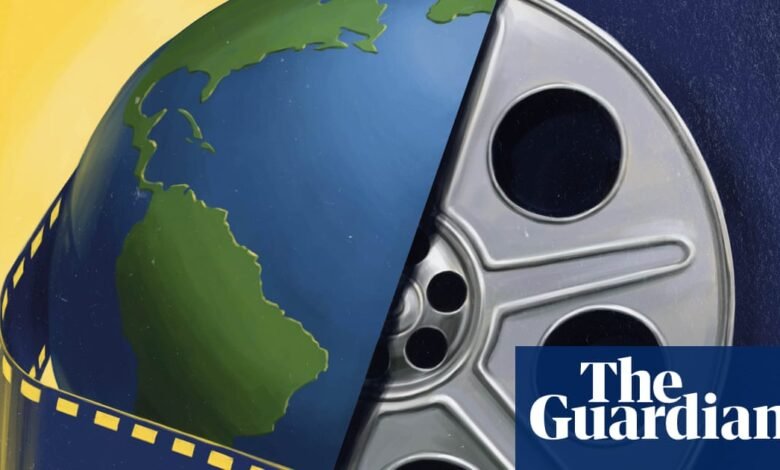‘This is big blissful entertainment’: global film critics on the one movie that defines their country | World cinema

India
Lagaan: Once Upon a Time in India (2001)
It is often said that there are two religions in India: cinema and cricket. Lagaan: Once Upon a Time in India blends the two with such panache that, upon its release, movie theatres became stadiums, with audiences cheering and dancing in their seats when the underdogs (a ragtag team of Indian villagers) defeat their masters (a far superior British team led by a tyrannical racist captain who wants to inflict a ruinous land tax on them).
It’s 1893, and a game of cricket transforms into an outsized battle between good and evil, coloniser and oppressed. Director and co-writer Ashutosh Gowariker and leading man and producer Aamir Khan created a film that revels in specifically Indian storytelling. There are joyous, colourful song and dance sequences (music by AR Rahman), an aching love triangle, a strong mother figure and a key life lesson: sach aur saahas hai jiske man main ant mein jeet usiki rahe (ultimately, the person who has truth and courage in his heart wins).
Lagaan – also only the third Indian film ever to be nominated for an Oscar – runs for three hours 44 mins. It is not for the timid. This is big, brilliant, blissful entertainment with a throbbing heart. Anupama Chopra
Mexico
Canoa: A Shameful Memory (1976)
When asked to name a film that represents Mexican cinema, the go-to choice is to turn to films from the Golden Age of the 1930s to 1950s, which offered idealised, picturesque visions of the country. Canoa breaks with that image entirely, yet it stands as one of the most essential films in the country’s history.
Directed by Felipe Cazals and shot in faux-documentary style, Canoa is based on real events: it reconstructs the 1968 lynching of five university employees who were mistaken for communist agitators in a remote village. The village priest, claiming to defend God but intent on preserving his own power, becomes the engine of hysteria, warning of “communists” with flags “red as hellfire and black as sin”. The outcome is revealed early: corpses on the ground, the violence already done.
Canoa’s ominous setting and unreliable narrators would be enough to make it a masterclass in suspense. But its force lies in how those tools expose a deeper national unease. Cazals, once a maverick for refusing to idealise or folklorise Mexico, is now seen as one of its most vital directors. Canoa not only broke with cinematic tradition; it anticipated present-day Mexican cinema, which increasingly turns toward the violence overtaking the country, the impunity surrounding it and the sense of vulnerability among its citizens. Fernanda Solórzano
France
La Bataille de Solférino (Age of Panic; 2013)
Although her 30-minute film Two Ships won best European short at the 2012 Berlinale, the director Justine Triet was not nominated for any of the major prize categories at Cannes the following year for her first full-length feature Age of Panic.
And yet, to just watch the film – to really watch it – is to feel that cinema itself was coming off its hinges. This story of a separated couple racing around Paris with their young children wrenched the French psychological drama away from its standard tropes of bourgeois arguments in flats or picturesque cafes. Set against the unpredictable backdrop of a tense national election night, the film is carried along by stressful waves of crisis-ridden energy in overspilling crowds. The intimate and the political constantly bump up against each other through sudden and sublime crescendos.
What followed – Victoria, Sibyl and the Palme d’Or-winning Anatomy of a Fall – blasted Triet into the spotlight. She is among a new generation of women film-makers – alongside Céline Sciamma, Rebecca Zlotowski, Valérie Donzelli and Alice Diop – who have in their own way renewed the French cultural imagination. It is now much less tentative or narrowly naturalistic in outlook, and less indebted to the New Wave.
With only 36,000 tickets sold in France, Age of Panic was a commercial flop. Still, if you were going to write an official counter-history of the films capturing a “French touch”, it would be an inarguable milestone. Didier Péron
The Philippines
Kakabakaba Ka Ba? (Will Your Heart Beat Faster?; 1980)
Tell any Filipino the title of this film and chances are, they’ll let out a chuckle. It’s a play on the rhythmic repetition of “kaba” (worry): the title’s rapid-fire syllables mimic the fast beats of an anxious heart. It’s a linguistic joke that simply vanishes with translation.
As such, Mike de Leon’s rock opera comedy can be considered an inside joke. Music, drugs, the Chinese mafia and the Japanese yakuza converge around a quartet of teenagers led by Filipino acting legend Christopher de Leon after his character unwittingly smuggles opium in a cassette tape.
The laughs come from deliriously over-the-top villains who represent the foreign forces shaping and manipulating the Philippine economy, all vying to retrieve the contraband. It revels in meta moments, from subtitle manipulation and dubbing shenanigans to a scene in which nuns in fishnet stockings sing about bread. It takes jabs at imperialism, satirises the Catholic church, and promotes the idea that stoned teenagers can save the day. Garnering the ire of real-life priests, nuns and the board of censors at the time of its release, this film didn’t just stretch the boundaries of the second golden age of Philippine cinema – it gleefully obliterated them. Ryan Oquiza
Kenya
Nusu Maisha Ya Nairobi (Nairobi Half Life; 2012)
In Nairobi Half Life, by Kenyan film-maker David “Tosh” Gitonga, a young movie seller and aspiring actor leaves his rural home for the capital to pursue an acting career. He is robbed of his possessions on his first day and ends up getting entangled in crime to survive. He starts living a double life: stealing and mugging as a gang member, and rehearsing a play as he chases his acting dream.
The film is a gritty portrayal of life in the city and how crime, corruption and class divisions affect society. It showcases the spirited energy of urban life in Kenya and powerfully captures the dreams of young people and the struggles they face to succeed. The film is rooted in Kenya’s cinematic tradition of storytelling, which often focuses on local stories that explore social themes. With its depth and authenticity, it was the country’s first submission to the best international film Oscar, and was a distinct addition to Kenya’s crime dramas, a prevalent genre in the country’s cinema. Carlos Mureithi
Argentina
Relatos Salvajes (Wild Tales; 2014)
There’s fizz and froth in Damián Szifron’s six tales of revenge, which capture the danger of a nation teetering on the edge of a breakdown. Martín Rejtman’s The Magic Gloves may have captured the chaos of Argentina’s 2001 financial crisis with a slyer absurdism, but Szifron’s compact sketches – which range from the poisoning of a loan shark to a wedding from hell – expose a plethora of ills across Argentinian society in both urban and rural landscapes. Class inequalities, labyrinthine bureaucracy, institutional corruption and toxic masculinity all rear their ugly heads in a film where characters are trapped in a violent cycle of repetition, evoking the tangled narratives of Jorge Luis Borges.
A top-notch cast, including the Argentinian everyman Ricardo Darín – the face of many of the best homegrown films of the 21st century, from the newly remastered Nine Queens to the Oscar-winning The Secret in Their Eyes – shape a motley crew of characters whose lines have become unlikely catchphrases in Argentina, where the film broke box office records.
Realised in an in-your-face colour palette, the film may not have the subtlety of compatriot Lucrecia Martel’s The Headless Woman – a film Szifron ingeniously references – or the narrative ambition of Mariano Llinás’s La Flor, but its exuberance and dark humour are rooted in a playful Argentinian storytelling tradition where nothing can be taken at surface level. Maria Delgado
Turkey
Umut (Hope; 1970)
A man, a cart, a dry tree. Decades later, Umut remains urgent. It’s the story of a poor coachman called Cabbar chasing a lost treasure. Desperation turns into madness: the film pushes us deeper into magical thinking, from harsh reality to myth.
Written, directed and acted by Yilmaz Güney, the film’s fierce rejection of individual salvation and neorealist lens transforms everyday visuals – a dusty landscape, boys on rented bicycles, faces of workers – into political statements. Shot in black and white, the film’s single dry tree becomes a haunting symbol, a promise that never comes true. The system keeps failing to protect the vulnerable, leaving helpless people praying to stones and begging healers for redemption.
after newsletter promotion
Current Turkish film-makers from Nuri Bilge Ceylan to Emin Alper and Yeşim Ustaoğlu carry on Güney’s legacy. The men in Ceylan’s Once Upon a Time in Anatolia dig for a buried corpse in order to find a truth, while the vast landscape similarly resonates the inner emptiness and existential dread. In the wonderful debut by Murat Firatoglu, One of Those Days When Hemme Dies, Turkey’s Oscar entry this year, a red tomato plain is a site of desperation and a power struggle. Esin Kucuktepepinar
China
Tie Xi Qu (West of the Tracks; 2002)
Wang Bing’s nine-hour epic offers a sweeping perspective on the collapse of a vast industrial community in north-east China at the turn of the century. The film lays bare the turmoil and disruption of that era: for China, it was a pivotal historical moment.
Despite its epic nature, West of the Tracks is a deeply personal work. In 1999, Wang Bing, alone with a Panasonic EZ1 camera, immersed himself in this industrial landscape. Over the next year and a half, he roamed the site, accumulating 300 hours of footage that would coalesce into this major social and historical work. This was an entirely individual initiative, conducted outside China’s film censorship system. And so the film has never been integrated into the official narrative of cinematic history.
Yet its significance was quickly recognised in the west, celebrated not for only its scale and story but also its realistic aesthetic. The film confronts and reshapes China’s dominant cinematic tradition of ideological film, and ushers it on to the global stage. Wang Bing worked under extraordinarily harsh conditions. When asked what sustained him, he has said: “I don’t know, truly, I don’t know.” Zhang Yaxuan
Nigeria
Saworoide (Brass Bells; 1999)
Tunde Kelani is a Nigerian film-maker who can make a legitimate claim to auteur status. Active before the Nollywood era kicked off around 1992, Kelani worked as a cinematographer before building an impressive oeuvre as a director and producer. His films embrace indigenous Yoruba literature and philosophy while making scathing sociopolitical commentary. His pièce de résistance has to be Saworoide, a political fable about the corruption of absolute power that resonates to this day.
Released in 1999, the same year that marked Nigeria’s return to democratic rule following a brutal military dictatorship, Saworoide’s precise and devastating reading of leadership and turmoil in the fictional Jogbo community is an obvious allegory for the Nigerian condition. A corrupt monarch ascends to the throne and, bolstered by the complicity of self-serving lackeys, begins a reign of terror that is matched only by his incompetence. He rejects the customary checks and balances on his power and soon meets his Waterloo. But as the people find out, things can get even worse.
Saworoide straddles elements that have come to define Nigerian cinema across the decades. Much like the output from Nollywood’s influential home video era, Saworoide is dialogue- and plot-heavy. It also contains nods to the travelling Yoruba theatre, popular in the 1970s. Kelani’s concise vision keeps the film visually dynamic and it plays very well on the big screen. Wilfred Okiche
Finland
Tulitikkutehtaan Tyttö (The Match Factory Girl; 1990)
No film-maker has done more for the picture of Finnishness than Aki Kaurismäki. The minimalist melodrama The Match Factory Girl was the final, best and most bleak entry in his Proletariat Trilogy, until he returned in 2023 with the lovely Fallen Leaves – a fairytale compared with this one.
Iris (Kati Outinen, queen of deadpan acting) is a timid factory worker who still lives with her mum and stepdad, whom she supports on her meagre earnings. She dreams of romance but nobody asks her to dance. Her life is all Finnish gloom: hard work, few words, low expectations, loneliness and shame. Every time she tries to break out she is crushed, yet she fights back. Miraculously, the film is both tragic and darkly funny.
Kaurismäki’s visual style is as instantly recognisable as Wes Anderson’s, but only he could bring out the beauty in these unexceptional settings and his protagonists, who are ordinary workers with laconic wit, grit and dignity. They can’t express their feelings in gestures or words, but Kaurismäki’s unsparing gaze never abandons them: this egalitarian respect for every person’s integrity is very Finnish. As for Iris, the smallest of sparrows: her stoic endurance of humiliation and cruelty makes one root for murder. Sara Ehnholm Hielm
Italy
La Grande Guerra (The Great War; 1959)
The Great War speaks to the Italian character after the second world war and the end of the fascist regime, and what it still is today.
It’s the story of two cowards trying to pass themselves off as model soldiers. Their refusal to act as soldiers doesn’t come out of a moral or political stance but an individual one: why should I risk my life? Let someone else do the job. It’s individualism, the Italian way.
The film was born out of director Mario Monicelli’s spite for the regime’s propaganda, which lionised the myth of Italy’s brave and bold heroism during the first world war. Monicelli’s film demolishes this story through comedy: it was revolutionary in 1959 and very bold. Like everything in Italian cinema from the end of the second world war until the early 60s, it was a step in the building of a new identity, and comedy is how Italians engage in the most serious affairs.
In the film, the soldiers – who deceive and bicker with each other – are captured by Austrians and face a sudden, moving change of heart. Although they have information that might save their lives, they decide to accept their fate and not betray their comrades. It’s a decision that both represents and inspires the Italian spirit: one of unconditional care for each other that compensates for a lack of collective consciousness. Gabriele Niola
Iran
Bad Ba Ra Khahad Bord (The Wind Will Carry Us; 1999)
Emerging from a moment shaped by Islamic modernism and Ayatollah Khomeini’s criticism of modern media – with its imperialist ways of seeing – Abbas Kiarostami’s The Wind Will Carry Us proposes a different way of looking. Eleven of the film’s main characters remain off screen, and the depths of the Earth – the dark caverns of the village of Siah Darreh – give voice to long-shrouded desires. Here, green hay moves as if of its own accord. In a rural village, time passes as if yesterday were a month ago, and an old villager lives to be 100 or so. As an urban film-maker and his crew wait for the elder’s passing so they can film their documentary on local funeral rites, a fabulated world appears on screen.
Film scholar Christian Keathley once wrote that: “Many viewers who watched the first films of the Lumière brothers were delighted less by the scenes being staged for their amusement than by the fact that, in the background, the leaves were fluttering in the wind.” This freedom of the eye to roam, away from the rigid coordinates of western commercial cinema, is the hallmark of Iranian cinema after the 1979 revolution. The Wind Will Carry Us teaches the eye to see differently: to look with wonder at things that lie elsewhere, beyond our lived reality. Negar Mottahedeh




